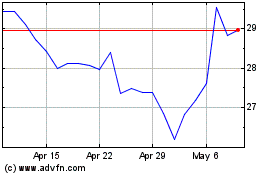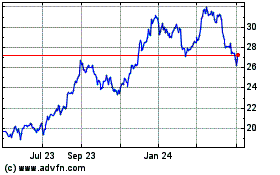China Consumer Inflation Unchanged in March
April 11 2016 - 1:30AM
Dow Jones News
BEIJING—Chinese consumer inflation in March held steady in
March, helped by a strong rise in pork prices.
China's consumer-price index rose 2.3% in March from a year
earlier, matching February's level, according to the National
Bureau of Statistics. The rise in the key inflation gauge undershot
a median 2.5% gain forecast by 14 economists in a survey by The
Wall Street Journal. Prices tend to fall after the Lunar New Year
holiday so the steady inflation level could take pressure off the
central bank for now to reduce interest rates, economists said.
"Although CPI is below expectation, it's good for the mood since
three months ago the market was worried about deflation and now
inflation is the concern," said Macquarie Group Ltd. economist
Larry Hu. "But I think policy easing will be less expansive than we
thought a few months ago since growth concerns have eased."
China's producer-price index, a measure of prices at the factory
gate, declined 4.3% in March from a year earlier, compared with a
4.9% drop in February, the statistics agency said. While the index
has remained in deflationary territory for over four years—as China
continues to have too many factories churning out goods there isn't
enough demand for—the results were better than economists
expected.
On Monday, the World Bank forecast growth in China of 6.7% this
year and 6.5% in 2017, warning that debt continues to expand faster
than economic growth as overcapacity weakens prices and investment
momentum.
Steady consumer inflation in March was supported by food prices
that remained relatively high after the Lunar New Year holiday, led
by higher pork and vegetable prices. The food-price component of
the index rose 7.6% on year in March, compared with 7.3% in
February.
Pork prices rose over 24.1% year on year during the combined
January-March period, official data show. According to Premise Data
Corp., which tracks global food consumption, pork tenderloin prices
reached over 80 yuan ($12.37) per kilogram in some supermarkets
over the weekend.
Nonfood prices rose a mere 1% in March, the same pace as in
February.
China faces something of a dilemma. While it wants to keep pork
and other food affordable to stem the potential impact on social
stability, it also welcomes some inflation, which helps companies
service their debt and can bolster corporate earnings and
demand.
In September 2011, after pork prices hit 30 yuan per kilogram,
panic buying saw people line up overnight and even get into fights
to buy inexpensive pork released by the government, said Dan Wang,
an analyst with research group EIU Access China, author of a recent
paper on the pork cycle. "People complain quite a bit when prices
go up," she added.
In a quarterly survey by the central bank released late last
month, 52.7% of consumers said consumer prices were "too high and
unacceptable," up 1.7 percentage points from the previous
quarter.
Song Fa, a 23-year-old technician, said recent rising food
prices, particularly involving fruit and pork, are also reflected
in restaurant prices. "Food is certainly more expensive now," he
said.
China has set a goal this year of keeping consumer inflation
below 3%, the same as last year. In recent years the actual rate,
which was 1.4% last year, has come in well below Beijing's
projected ceiling. UBS said it expects consumer prices to peak in
the second quarter before inflation eases in the last half of the
year to post a 1.9% rate in 2016.
Prices on the factory floor remained in negative territory in
March for the 49th consecutive month, but fell at a less rapid rate
as prices of steel, rubber and ferrous and nonferrous metals
rebounded, according to the Commerce Ministry. But the Chinese
economy continues to suffer from industrial price deflation and
overcapacity.
Beijing recently announced plans to close up to 13% of steel
capacity and lay off about 4% of steelworkers over the next several
years, but analysts say the announced capacity cuts are a third to
a half of what would be needed to eliminate excess capacity.
Liyan Qi contributed to this article.
Write to Mark Magnier at mark.magnier@wsj.com
(END) Dow Jones Newswires
April 11, 2016 01:15 ET (05:15 GMT)
Copyright (c) 2016 Dow Jones & Company, Inc.
UBS (NYSE:UBS)
Historical Stock Chart
From Mar 2024 to Apr 2024

UBS (NYSE:UBS)
Historical Stock Chart
From Apr 2023 to Apr 2024
